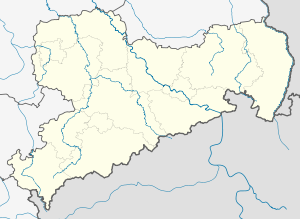Schlachthofbrücke (Dresden)
Coordinates: 51 ° 3 ′ 58 " N , 13 ° 42 ′ 59" E
| Schlachthofbrücke | ||
|---|---|---|
| use | Road bridge | |
| Crossing of | Ostra flood channel | |
| place | Dresden | |
| construction | Composite steel bridge | |
| overall length | 315.48 m | |
| width | 12.5 m | |
| Longest span | 26.1 m | |
| location | ||
|
|
||
The slaughterhouse bridge is a road bridge in Dresden , the Ostra-flood channel, a left hand, the same preferred Flutmulde of the flood protection spans. In the Ostragehege it connects Friedrichstadt with the Dresden Exhibition Center , on the area of the former municipal cattle and slaughterhouse . The steel bridge from 1932 was then considered the longest electrically welded bridge in the world.
history
With the construction of the Alberthafen in the south of the Great Ostragehege, between 1891 and 1895, a 300 m wide flood channel was created north of the harbor and a large embankment as a circulating mountain . Between the years 1906 and 1910, the city of Dresden built the embankment with the municipal cattle and slaughterhouse, which was accessed by two bridges over the flood channel. These were a 386 m long railway bridge with 23 spans, which was demolished in 2006, and a wooden road bridge.
To replace the wooden bridge, a steel bridge with 13 spans was built in 1931 and 1932. Until 1979, a single-track tram route to the Ostragehege was run over the structure.
As part of the new construction of the trade fair on the slaughterhouse site, the slaughterhouse bridge underwent a general overhaul in 1999 with a new superstructure. The geometry of the pillars remained unchanged.
In addition to the Schlachthofbrücke, a second bridge was built from 2010 to expand tram line 10. The main reason for the extension was the better connection of the Dresden Exhibition Center to local public transport, also with a view to the 2011 German Evangelical Church Congress in Dresden .
Bridge from 1932
The new, 315.5 m long bridge had an 8.5 m wide carriageway and had 1.62 m wide sidewalks on both sides. There was also a tram track in the middle. The steel superstructure construction at that time was designed for lifting in order to meet the requirements of a possible expansion of the König-Albert-Hafen.
The superstructure consisted of two steel, 2.0 m high solid wall girders in the longitudinal direction , which were arranged at a distance of 8.9 m. In the transverse direction, the main girders were connected to one another by 1.17 m high cross girders at a distance of about 4.0 m. The carriageway slab was made of reinforced concrete and was connected to it in a shear-proof manner by angles welded onto the cross members. In the longitudinal direction of the bridge there was a chain of tanner girders as a structural system, which also had two expansion joints .
Both the main and the secondary girders were completely welded sheet metal girders, only the construction site connections between these, consisting of lamellas and angles, were riveted . A total of 14 km of welding seams were made with electric arc welding, both by hand and with an automatic machine. At that time the bridge was considered the longest electrically welded bridge in the world. The superstructure was and is still supported today on twelve massive pairs of pillars with hexagonal ground plans. The total construction costs amounted to 520,000 RM. A total of 468 t of structural steel was used.
Bridge from 1999
The old superstructure was replaced by a modern steel composite construction with the continuous beam as a structural system in the longitudinal direction. The 12.5 m wide reinforced concrete deck is designed for two lanes and sidewalks on both sides. The total length remains unchanged at 315.48 m and is made up of individual support widths of 3 × 22.08 m, 7 × 24.42 m and 3 × 26.10 m. The construction costs amounted to 4 million DM, including 523 tons of structural steel and 460 tons of reinforcing steel .
Bridge from 2011
The double-track tram bridge was built from 2010 to 2011. It is 8.45 m wide. Prestressed double composite beams were used for the superstructure.
Web links
Individual evidence
- ↑ Sachsenschiene homepage: engineering structures / route DEH bridge flood channel Ostragehege
- ^ R. Leonhardt: The longest electrically welded bridge in the world. In: The civil engineer. 15th year, 1934, pp. 228-229.
- ^ Website of Wiebe Holding GmbH & Co. KG .: References - Schlachthofbrücke Dresden ( page no longer available , search in web archives ) Info: The link was automatically marked as defective. Please check the link according to the instructions and then remove this notice.
- ↑ Oliver Schreiber, Tina Klingelhöfer: The tram bridge "Messe Dresden" - bridge construction with Preflex girders. In: Bridge Construction. March 2011 edition, pp. 16–20

